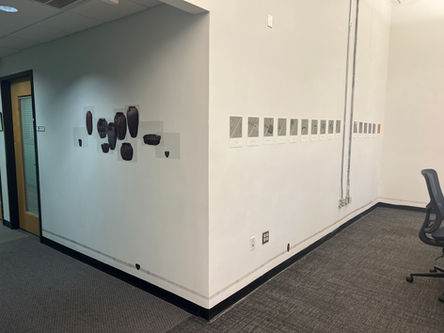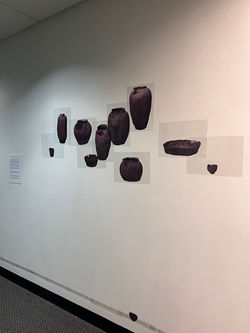단체전
프로비던스의 이방인들
2024. 08.09 - 2024. 08. 25
스프라우트 갤러리, 프로비던스, 로드아일랜드, 미국
전시 서문
■ _비엔날레 소개
_비엔날레는 2년마다 새로운 도시로 이동하며 열리는 예술 행사이다. 이를 통해 우리는 지역적 다양성을 증진하고, 미술 권력의 탈 중앙화를 실현하며, 해당 지역 작가들과의 협업을 강화하고자 한다. 이러한 접근 방식을 통해 기존의 비엔날레와 차별화된 방향성을 제시하며, 각 도시의 문화적 특성을 반영한 다채로운 예술 경험을 제공하기를 기대한다.
■ 들어가며
전시는 이방인으로서의 개인을 드러내고, 그 사이 연대의 가능성을 모색한다. 알베르 까뮈의 소설 [이방인]에서 주인공 뫼르소는 자신의 감정과 생각에 정직한 인물로, 사회적 규범에 무관심하게 살아간다. 이로 인해 그는 사회적으로 ‘이방인’으로 여겨지며, 결국 비극적인 결말로 향하게 된다. 뫼르소만큼은 아니더라도, 우리는 종종 사회적인 가치에 의문을 품는다. 출근을 해야 하지만 아침에 일찍 일어나기 힘들 때, 불편한 자리에 참석해야 할 때, 사회에 비극적인 인재가 닥쳤을 때. 이러한 순간들은 익숙한 장소에서조차도 우리를 이방인으로 만든다.
프로비던스는 로드아일랜드 주의 중심 주도 지명으로, 사전적 의미로는 세상과 우주 만물을 다스리는 신의 뜻이다. 프로비던스의 역사는 메사추세츠만 식민지역의 목사로 있던 로저 월리엄스가 교회와 주의 역할의 분리를 옹호하고, 식민지 개척자들이 인디언(토착민)들로부터 토지를 몰수하는 것이 부당하다는 것을 주장하자, 식민지역에서 그를 이단으로 취급하고 유죄 판결을 내려 추방시키면서 시작되었다. 쫓겨난 윌리엄스는 토착민으로부터 도움을 받아 현재 프로비던스가 있는 곳으로 이동하여 정착하게 되었다. 영국에서 신대륙으로 이주해온 이들은 이방인이었다. 하지만 동시에 원주민 역시 그들의 삶의 터전을 빼았기면서 이방인이 되었다. 윌리엄스는 당시 영국인들이 원주민들을 천시하고 학살하는 것을 비판하며, 원주민들과의 평화로운 공존을 주장했다. 이방인과 이방인 사이의 연대를 제안한 것이다. 소설에서 뫼르소는 결국 그의 태도와 선택으로 인해 사회로부터 완전히 소외되고 만다.
윌리엄스의 예시처럼, 우리는 이러한 한계를 극복하는 방법으로 연대를 제시한다. 우리가 느끼는 낯선 감각은 각자의 삶에서 느끼는 고유한 감각이지만, 동시에 우리를 서로 연결하는 공통점이 되기도 한다. 전시에서 작가들은 다른 작가의 작품 요소(정신, 목소리, 매체, 주제, 영감 등)를 자신의 작품에 연결하여 서로의 방식을 이해하고 공감하고자 시도한다. 이러한 과정을 통해 우리는 홀로 느끼던 낯선 감각을 넘어서 연대의 힘을 발견하기를 기대한다.
■ About _biennale
The _Biennale is an art event that moves to a new city every two years. In doing so, we aim to promote regional diversity, decentralise artistic power, and strengthen collaborations with local artists.
With this approach, we hope to offer a different direction from traditional biennials and provide a diverse art experience that reflects the cultural characteristics of each city.
■ From the art director
I am Kahee Bae, the art director for this exhibition. It is a bit daunting but also a very meaningful opportunity to hold the first session here in Providence, where I currently reside.
Connecting Experience with Exhibition Theme
The title of the exhibition, "Strangers of Providence," literally means the strangers of Providence. It refers to the people who have gathered in Providence for various reasons, such as to gain knowledge or to teach students, like myself. When I moved to Providence for my education, I felt like a stranger here. In classes, when students would freely express their opinions and ask honest questions, I found myself unable to speak, fearing I might make a mistake. I felt out of place and worried that the professor might view me as a student who wasn't actively participating. There were days when I felt upset and spent the entire day in anxiety.
Living in a new place far from home can be unfamiliar and awkward until you adapt. We go through many trials and errors to fit in because the culture, social values, and even ways of thinking can be different from what we are used to.
However, we often feel like strangers not only in a physical sense but also within our own communities or society. This sense of alienation, the peculiar feeling of not quite belonging, can be experienced in everyday life.
Therefore, while the title is "Strangers of Providence," it encompasses not only the strangers living here in Providence but all of us in such situations. The Process of Naming the Exhibition and Sources of Inspiration
The exhibition is inspired by the character Meursault from Albert Camus' novel "The Stranger" and Roger Williams, the founder of modern-day Providence.
Explanation of "The Stranger"
Let's briefly look at the plot of Albert Camus' "The Stranger." The novel tells the story of Meursault, a man who lives very honestly but is indifferent to social norms. The novel is divided into two parts. The first part starts with the funeral of Meursault's mother and ends with him shooting an Arab. The second part deals with Meursault's trial for the murder and ends with him awaiting his execution.
Meursault shows an indifferent attitude towards significant events such as his mother's funeral and the act of murder, which is markedly different from how people usually react to death. In the courtroom, his lawyer urges him to hide his genuine feelings and to pretend to feel guilty and remorseful. However, during the trial, neither the prosecutor nor the defense lawyer asks Meursault for any statements, and they only argue their points among themselves. Eventually, the judge, concluding that Meursault committed premeditated murder, sentences him to death.
History of Providence/Roger Williams
Before introducing Roger Williams, I would like to give a brief overview of Providence. Providence is located in Rhode Island, the smallest state in the US. Unlike Seoul or New York, you won't see many high-rise buildings here, but rather, buildings reminiscent of classic European architecture. This is due to Providence's history. When people first crossed over from England to the New World, they landed on the eastern coast of America. Since Providence is located on the eastern edge, the buildings were constructed in the English architectural style of that time.
However, the English did not immediately settle in the area that is now Providence. The area was originally inhabited by Native Americans. The settlers first settled in Massachusetts. Roger Williams, like many Englishmen of that time, first settled in Massachusetts. As a minister, he engaged in trading goods brought from England with the native Narragansett tribe, forming close relationships with them. However, the English saw the natives as inferior and evil, leading to territorial expansion and massacres. Although the English became strangers in the New World, the natives, who had lived there for a long time, became strangers in their own land due to the English settlers.
Williams criticized the un-Christian actions of the English, advocating that the natives had the rightful ownership of their land. Despite multiple warnings from the Massachusetts Bay authorities, he continued to condemn the English actions and was eventually banished. With the help of the natives he had traded with, Williams was given a piece of land and, along with some English supporters, moved to what is now Providence, establishing a peaceful relationship with the natives and creating a community based on understanding, tolerance, and solidarity.
Conclusion
In Camus' novel, Meursault is completely alienated for his honest emotions and actions, deviating from societal norms that dictate sadness in the face of death. In contrast, Roger Williams sought to eliminate conflicts between natives and settlers and create a sense of unity and connection.
When Meursault was sentenced to death, it was not just by the judge but by society as a whole. In the novel, Meursault is a stranger who does not conform to societal values and norms, much like us when we deviate even slightly from what is expected. Despite this, Meursault's daily life, enjoying swimming at the beach on a sunny day, watching movies, and spending time with loved ones, is not so different from ours.
We often fail to understand and label as different anyone who deviates even slightly from social conventions or values. A classic example is when someone at a company dinner, where the boss says, "Today is on me, eat as much as you want, I'll have the black bean noodles," and someone dares to order sweet and sour chicken, causing a shocked silence. "No one has the right to mourn the death of their mother." This sentence highlights that social values and norms are merely conditions set to create reasonable standards in society, not absolute measures of right and wrong.
What are social values? Although the novel uses the extreme example of death, even if we are not as extreme as Meursault, we often question social values. Like the example I mentioned earlier, can't we just honestly say what we want to eat? Roger Williams also questioned social values. He challenged the English belief that it was acceptable to take land from the natives because they were inferior, instead constantly communicating with and understanding the natives, questioning his society, and working to embrace and unite the strangers. In conclusion, through this exhibition, we want to emphasize the importance of solidarity in overcoming such boundaries, as exemplified by Williams. The sense of alienation we feel is a unique experience in each of our lives, but it also serves as a common thread that connects us.
To explore and understand the sense of strangeness we each hold, we first received the artists' works. The artists then observed each other's works, interpreted the elements in their own way, and incorporated them into their own creations, resulting in a new body of work. Through the artists' attempts to understand the sense of being a stranger, we hope that you, too, can discover new possibilities for solidarity.
■ The way of matching artists
Kahee Bae → Joohee Park
In Park Joohee's works, the use of materials such as cement and iron mesh directly reveals the structured reality of society. In contrast, Bae Kahee's works use the element of tulips to metaphorically critique the controlled social reality. Considering this, what aspects of Kahee's work might directly address issues of social structure, and how can these be connected to the elements in Joohee's works?
Joohee Park→ Seongjoo Moon
Park Joohee's "Labor Container” is set in spaces where grandmothers engage in labor. In Moon Seongjoo's work, the river represents a symbolic space created by our social structures, a barrier difficult to cross, highlighting marginalized individuals. While the bowl symbolizes the tools of the grandmothers' labor, the river represents the space where their labor is performed and concealed. Combining the image of the river in "Labor Container" can bring attention to marginalized people and prompt reflection on our perspectives towards them.
Seongjoo Moon → Seungwon Baek
Seongjoo Moon talks about the ways to cross an unknown river. So, what kind of place is the river? Just as Seungwon Baek focuses on and contemplates the unfamiliar landscapes of Providence from an outsider's perspective, I hope Seongjoo can also take this opportunity to explore the place called 'the river.'
Seungwon Baek → Kahee Bae
Both Baek Seungwon and Bae Kahee's works speak to the importance of solidarity. Seungwon discusses the solidarity of individual Strangers, while Kahee approaches the solidarity of Strangers from a macro perspective. By incorporating Kahee's perspective into Seungwon's works, we can consider a broader concept of solidarity beyond the individual viewpoint.
Jaewon Hwang ↔ Ana Popescu
In Ana Popescu's works, the perspective of a Stranger is considered amidst contradictory situations encountered in changing physical environments. Ana Popescu's works prompt reflection on the Stranger amidst the contradictory situations caused by changes in the physical environment. In contrast, Hwang Jaewon's works attempt to detach from the rapid flow of information online. Faced with physical or non-physical states of being Strangers, they each focus on the fear and contradictions of unfamiliar landscapes, not letting them pass by but slowly weaving them into their own time. Ana can reflect on the non-physical contradictions in Jaewon's works that can be connected to her own, while Jaewon can contemplate the physical contradictions encountered in Ana's works, exploring the possibility of expanded solidarity.









